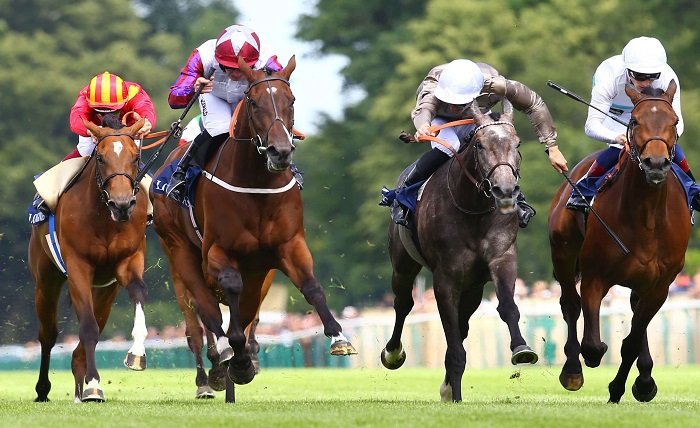The Thoroughbred Horse’s Nutrition: Fueling Champions

Thoroughbred horses are the epitome of speed, agility, and endurance in the world of horse racing. These elite athletes require a meticulously balanced diet to perform at their peak, much like human athletes. In this article, we will delve into the specifics of what goes into the feed bins of these magnificent creatures, shedding light on the carefully curated nutrition plans that thoroughbred trainers rely on to prepare their horses for the track.
Understanding the Basics: The Role of Macro-nutrients
At the core of any thoroughbred’s diet are the macro-nutrients: carbohydrates, proteins, and fats. Carbohydrates are the primary energy source for these horses, with oats, barley, and corn being common staples in their feed. These grains are rich in starch, which breaks down into glucose, providing the energy needed for those powerful sprints.
Proteins are equally crucial, playing a vital role in muscle repair and growth. Alfalfa hay, soybeans, and other legume-based feeds are typical protein sources. However, it’s not just about quantity but quality. Trainers often opt for feeds with a high amino acid profile to ensure their horses are getting the best for muscle development and recovery.
Fats, while lesser in proportion compared to carbs, are an essential energy reserve. Vegetable oils like corn or flax-seed oil are commonly added to the diet to provide a concentrated source of calories without adding bulk. Fats are particularly useful during training and race seasons when horses need sustained energy without the risk of colic from overfeeding grains.
Micronutrients: The Unsung Heroes
Beyond the macro nutrients, micro nutrients play a pivotal role in a thoroughbred’s performance and overall health. Vitamins and minerals are critical for bone strength, immune function, and metabolic efficiency. Calcium and phosphorus, for example, are vital for bone development, especially in young horses, while electrolytes like sodium, potassium, and chloride are essential for muscle function and preventing dehydration during intense training and races.
Vitamin E and selenium are often supplemented to support muscle health and prevent oxidative stress. These antioxidants help in reducing muscle soreness and improving recovery times, which is crucial for a horse that races multiple times a season. Trainers also ensure that the diet is rich in B-vitamins, particularly biotin, which supports hoof health—a critical factor given the wear and tear a thoroughbred’s hooves endure.
Feeding Strategies: Timing and Frequency
Feeding a thoroughbred isn’t just about what they eat but also when and how often they eat. Trainers typically split the daily feed into multiple small meals to prevent digestive issues like colic and ulcers, which thoroughbreds are prone to due to their high-stress lifestyle. By spreading out feedings, the horse’s digestive system isn’t overwhelmed, and energy levels remain consistent throughout the day.
Moreover, the timing of feeding in relation to training and racing is meticulously planned. For instance, a high-carbohydrate meal is often given a few hours before a race to ensure that the horse has ample glucose available during the high-intensity exercise. On the other hand, post-race meals focus on proteins and fats to aid in recovery and replenish energy stores.
It’s also essential to manage water intake carefully. While hydration is crucial, horses should not drink excessively before a race to avoid discomfort. Trainers ensure that horses are well-hydrated throughout the day but monitor and moderate intake closer to race time.
Special Diets: Tailoring Nutrition to Individual Needs
Every thoroughbred is unique, and so are their dietary needs. Some horses may require specialized diets due to allergies, metabolic issues, or specific performance goals. For example, horses with insulin resistance or a tendency to gain weight may be put on a low-starch, high-fiber diet to manage their blood sugar levels.
On the other hand, a horse that’s prone to tying-up—a condition where muscles become stiff and painful—may benefit from a low-carbohydrate, high-fat diet combined with specific supplements like vitamin E and selenium. These tailored diets are crafted based on regular veterinary assessments and the horse’s performance data, ensuring that every dietary tweak is made with precision and purpose.
Another important aspect is the inclusion of prebiotics and probiotics in the diet. These supplements support gut health, enhancing nutrient absorption and overall well-being. A healthy gut is crucial for maintaining the energy levels and endurance required in races, making these supplements a staple in many thoroughbred diets.
Conclusion: The Impact of Nutrition on Performance
In the competitive world of horse racing, every detail counts, and nutrition is no exception. The meticulous care and attention given to a thoroughbred’s diet are a testament to the importance of proper nutrition in achieving peak performance. From macronutrients to micronutrients, feeding strategies to specialized diets, every aspect is carefully managed to ensure that these horses are not just fit but race-ready.
As any seasoned trainer will tell you, the right nutrition plan can be the difference between a champion and a runner-up. And for those looking to bet on horses, understanding the role of diet in a horse’s performance could provide valuable insights. After all, a well-fed horse is a fast horse, and in the world of thoroughbred racing, speed is everything.
By ensuring that their horses receive the best possible nutrition, trainers are laying the foundation for success on the track, one meal at a time.
Read more about: 99 math





